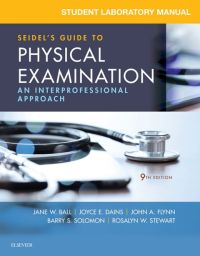New to this edition
- NEW! Updated content reflects the latest research and evidence-based practice.
- NEW! Engaging, student-friendly Terminology Review Activities ensure mastery of the language of health assessment and physical examination.
- NEW! Enhanced emphasis on patient safety and healthcare quality with new Patient Safety Considerations equips you for safe clinical practice
- NEW! Enhanced emphasis on clinical reasoning fosters the development clinical judgment skills.
Author Information
By Jane W. Ball, RN? DrPH? CPNP, Chief Nursing and Content O? cer,Triaj, Inc, Havre de Grace, Maryland; Joyce E. Dains, DrPH, JD, APRN, FNP-BC, FNAP, FAANP, FAAN, Professor and Executive Director, Advanced Practice, The University of Texas M. D. Anderson Cancer Center, Houston, Texas; John A. Flynn, MD, MBA, MEd, Professor of Medicine;The University of Chicago,Chicago, Illinois; Barry S. Solomon, MD, MPH, Professor of Pediatrics,Chief, Division of General Pediatrics;Assistant Dean for Medical Student A? airs,The Johns Hopkins University,School of Medicine,Baltimore, Maryland; Rosalyn W. Stewart, MD, MS, MBA, Professor of Medicine and Pediatrics;The Johns Hopkins University School of Medicine,Baltimore, Maryland and Frances Donovan Monahan, PhD, RN, ANEF, Consultant in Nursing Education, Vero Beach, FL, USA
1. The History and Interviewing Process
2. Cultural Competency
3. Examination Techniques and Equipment
4. Taking the Next Steps: Clinical Reasoning
5. Recording Information
6. Vital Signs and Pain Assessment
7. Mental Status
8. Growth and Nutrition
9. Skin, Hair, and Nails
10. Lymphatic System
11. Head and Neck
12. Eyes
13. Ears, Nose, and Throat
14. Chest and Lungs
15. Heart
16. Blood Vessels
17. Breasts and Axillae
18. Abdomen
19. Female Genitalia
20. Male Genitalia
21. Anus, Rectum, and Prostate
22. Musculoskeletal System
23. Neurologic System
24. Sports Participation Evaluation
25. Putting It All Together
26. Emergency or Life-Threatening Situations
Student Performance Checklists
Answer Key




